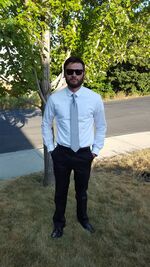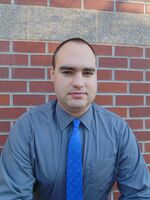Sorting of Titanium Fittings
| Final Prototype for Unions with parts in progress | |
| Sponsor | Boeing |
| Team Name | Titanium Fittings Sorting (TFS) |
| Duration | Fall 2016 - Spring 2017 |
| Faculty Advisors | Dr. Steven Beyerlein |
| Mentor | Alex Olson |
| Students |
|
Automation of simple jobs is becoming more common among companies, large and small. Our team was tasked with creating a automated reorienting system that could take titanium fittings of a range of sizes and orient them to pass them through an acid bath with little to no human involvement.
Problem Definition
Background
Boeing's aeronautics requires a large amount of fittings per aircraft for the different types of electrical and liquid systems that keep them flying in all weather conditions. To do this, Boeing has fittings machined from titanium in differing sizes. Before the fittings can be welded into place, they must be passed through a chemical bath to cleanse the parts of any contaminants. With their current setup however, the process of getting the fittings on rails for the chemical bath is extremely time-consuming, taking up to 8 hours of work by hand.
Deliverables
The final deliverable for this project will be a working prototype that can orient all the fittings despite the differences in size, center of mass, and weight.
Specifications
The specifications for the final prototype are:
- 6 feet by 6 feet maximum footprint
- Human involvement in setup only
- Uses 110 Volts
- No visible blemishes/markings on the fittings after sorting
- A maximum of 80 psi air if necessary
These specifications are the maximum that can be used. This list is also incomplete; more information will be added in as the project progresses.
Project Learning
Client Interview
Every few weeks, the team contacts the liaison for Boeing to describe what we have worked on in that time. This time is also used to get new information, ask specification questions, and make major decisions on the prototype.
Lead Instructor and Technical Advisor Meetings
Once per week, the team will meet with either Dr. Steven Beyerlein or with Alex Olson to make more minor decisions on the planning or the prototype. Other meetings can be made for brainstorming sessions, but meeting with the instructor is only mandatory once per week.
Sorting Processes
A multitude of sorting processes are already in use, and after touring a sorting facility, the team has looked into four different types:
- Hopper and Vibration System - By utilizing vibrating plates or channels, the parts can be sent down a path which can then be used to orient the parts.
- Pinwheel Coalator - A rotating drum which has angled pegs for the parts to tumble onto, which are then carried up and dropped into a tube in the correct orientation.
- Vibration Plates - A plate with holes is set at an angle and set to vibrate, so that the parts can tumble in. The holes are specifically designed so that the parts can only fall in one orientation.
- Conveyor Belt - A conveyor belt has the parts poured over it. A vertical plate is placed above the belt so that any parts that are not in the proper orientation are pushed off.
All these systems have a system to send the parts back to the beginning for reorienting.
Prototypes
Prototype 1
An early prototype that was used was a combination of orienting methods. The plan was a multistage system with vibration plates, each stage sending the parts through to orient them in specific ways. By using the geometry of the parts, the design rejected any improperly oriented parts and send them back to the starting hopper to be reoriented. Any part can be continually fed through the system until it was oriented properly.
Prototype 2
The next prototype was a continuation and improvement of the previous one. Each stage consists of a vibration plate, and each stage orients the parts in one plane. The parts are then passed onto the next stage. This prototype was made primarily of wood, and was simply used as a proof of concept for the different types.
Pickup Prototype
The original prototype for the pick up section at the end of the paths was a hard plastic trough with a perpendicular slot to allow the fingers of the rack to slide through, sliding into the hole of the unions. However, this proved to be difficult to perform quickly. As such, it was first adjusted so that the guide slot was made of stiff plastic, and later changed again to be at an angle, as well as being a cone to guide the fingers in better. Another change was to add a roof long enough to cover all but the last part. This allowed for the final part to be pulled out of the trough, but the other parts to not be pulled out with it or fall over. This set up, with angled guide slot and roof, is the current model.
Vibration Table
A vibration motor was needed to get the pieces to move down the pathways to be oriented. The motor that was used previously had enough power for one or two stages, but not for the full prototype. As such, a larger scale vibration table is being designed and built. The current design is to have a 2' by 2' plate connected to a motor with an offset weight, so that the table vibrates at a desired speed and amplitude.
Return System
The current model for a return system for rejected parts is to have a conveyor belt carrying the parts back up along the main ramp to be deposited back into the main hopper. The belt would have paddles to prevent the parts from rolling backwards down the belt, and would end with a small short ramp just above the main hopper.
Team Information
| Cody Smisek |
| Mechanical Engineering |
| Email: smis1557@vandals.uidaho.edu |
| John Hansen |
| Mechanical Engineering |
| Email: hans7663@vandals.uidaho.edu |
| Josh Howard |
| Mechanical Engineering |
| Email: howa8851@vandals.uidaho.edu |
| Juvy Tongco |
| Mechanical Engineering |
| Email: tong8429@vandals.uidaho.edu |
| Evan Bonar |
| Mechanical Engineering |
| Email: bona7484@vandals.uidaho.edu |








